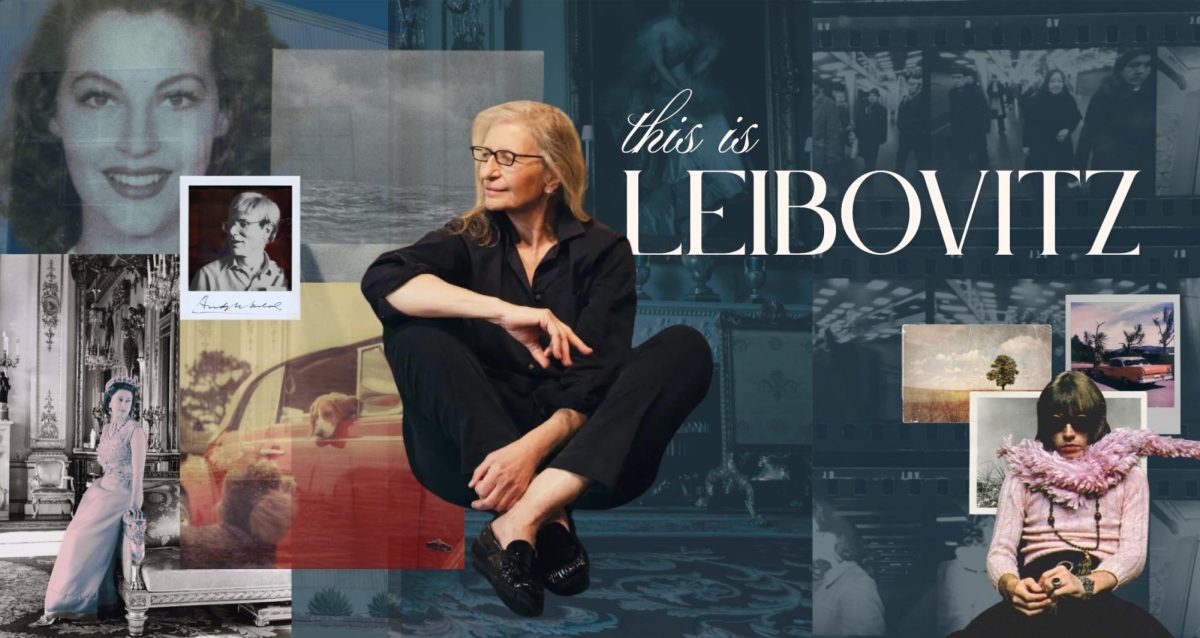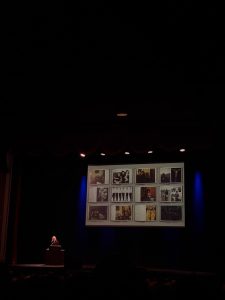
Ripples Turquand
By Ripples Turquand
Age is not a determining factor of what you do, who you are, or what you aspire to be. When you have a passion, it keeps you alive. It gets you up in the morning.
On Wednesday night, world-renowned photographer Annie Leibovitz took the stage at Southern Methodist University to present work from her book Women. The Dallas Museum of Art hosted the event in the McFarlin Memorial Auditorium, featuring her latest images on the subject.
Annie Leibovitz might sound familiar, as she recently photographed Timothee Chalamet for Vogue’s December edition.
Adorned in simple jewelry and a burgundy velvet pantsuit, Leibovitz commanded the crowd with poise, comedic relief, and direct purpose: to voice women’s stories through images.
A photography book is much different from a regular book; we don’t have chapters to follow, an index to refer to, or a preface to see how the story will begin. So, Leibovitz was forced to be intentional with her picture placement. Leibovitz described how each image tied into the others, and how each woman photographed had something in common.
Inspired by a German photographer, Angus Sander, who photographed through every walk of life, Leibovitz photographed women from many ages, socioeconomic statuses, and professions.
Leibovitz takes pride in the women she photographs, and each portrait in her presentation came with its own story. While it isn’t possible to unpack every image here, a few standouts reveal how intentionally she frames each woman’s experience.
Part I
On the title page of her first book, Leibovitz placed a photograph of her mother, Marilyn Leibovitz. Leibovitz described her mother as being in her mid-70s and insecure about looking old. Feeling vulnerable and withered, Leibovitz captured raw, simple emotion.
Opening the book with her mother’s portrait creates the framework for the project: each woman possesses a distinct presence or gift, and Leibovitz reveals these qualities through her editing style and the concise biographies accompanying each image.
Leibovitz also described how her mother’s photograph raised the bar for the rest of her photography, saying her subjects need to be “looking at me through the camera as if I’m not there. I want to see the person. I don’t want them to see me.”
Leibovitz flipped through pages of female farmers, astronauts, coal miners, bearded ladies, a woman living in a public restroom, and victims of domestic violence with swollen bruises on their faces.
Annie Leibovitz provided a platform for the most overlooked and undervalued women in our society to share their stories. They are not seen by society, but seen by Annie.
She told the crowd stories about how Ann Richards, Former Governor of Texas, being pictured with a gun was “really a hoot. Can’t keep up with her.” Next, Jane Roe from Roe v. Wade and how she’s aged beautifully. While warmly recounting her photo shoot with Martha Stewart, Leibovitz endearingly remarked, “I have a few things to say about Martha Stewart.”
Part II
In her second book, Leibovitz confronted the way society assigns value to women’s bodies and lives. That same focus shapes her newest project, which she summed up with three simple but telling words: many complicated women.
Leibovitz illustrated the female body as a timepiece, one that can chime beautifully at any age of life. She wished that the women’s bios were put at the front of the book for more attention, as it’s hard to encapsulate years of life into a few sentences.
On the title page, Leibovitz placed a picture of Susan Sontag, her past romantic partner. Leibovitz reminisced about how Sontag did not want to be outside in the photoshoot. Her emotions were tense, and the viewers can sense the cold feeling through the photography.
There’s also some scandal in the mix. As Leibovitz flipped through the book, she stopped on a photo of Stormy Daniels sitting on a horse, hair blowing back and a bit of cleavage showing. Daniels is usually talked about because of the political scandal tied to a former president, and society tends to judge her harshly because she works in adult entertainment. But Leibovitz’s photo shows her differently—strong, glamorous, and worth paying attention to. It’s a good example of how Leibovitz helps women feel seen through her photography, no matter how the world labels them.
Other prominent images include Michelle Obama, First Lady of the United States, with natural, long hair, a gray Henley t-shirt, and jeans. Joan Didion, American writer and journalist, in her simple Central Park office. Alice Walton, the richest woman in the world, in a well-decorated living room. Simone Biles, gymnast, in a dress that accentuates her back muscles.
Leibovitz spoke about how she wants to “meet the person, not the costume they have on.”
Lynsey Addario, who wore a brave face during her coverage of Afghanistan post-9/11. After years of being tortured, beaten, and kidnapped, Addario carries the war inside her skin. Leibovitz wanted to see Addario in an authentic state, one that was both vulnerable and courageous in front of the camera.
To lighten the mood, Leibovitz included a nude picture of Lady Gaga in Tony Bennett’s recording studio. She described it as “rowdy” as her assistants did “not know where to look. I’m older, and I want people to be clothed. But when I was younger, of course, Mick Jagger had to have his shirt off.”
And finally, a photograph of her children at the end of the book.
Photography may capture a single moment, but through Leibovitz’s expertise and care for her subjects, she’s able to compile emotion, history, and life’s story into a singular picture.
